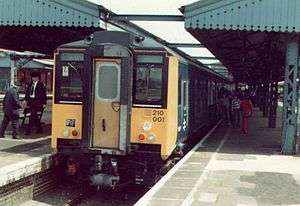British Rail Class 210
| British Rail Class 210 | |
|---|---|
|
Class 210 001 at Reading for a service to Didcot Parkway on 30 May 1982 | |
| In service | 1981–1987 |
| Manufacturer | BREL Derby Works |
| Family name | BR Second Generation (Mark 3) |
| Number built | 2 |
| Formation |
4 cars (210 001) 3 cars (210 002) |
| Capacity |
254 (210 001) 203 (210 002) |
| Operator(s) | British Rail |
| Specifications | |
| Maximum speed | 90 mph (140 km/h) |
| Prime mover(s) |
1 x MTU 12V396 TC11 (210 002) 1 x Paxman 6RP200L (210 001) |
The British Rail Class 210 was a type of diesel-electric multiple unit (DEMU) built in the early 1980s. The class was intended to be a modern replacement for the ageing 'first generation' types in use on the Southern Region of British Railways (classes 201 to 207) but the prototypes built did not manage to secure production for the class and they were withdrawn in the 1980s.
Design
The class were externally very similar to the first batch of Class 317 EMUs, but half of the forward carriage was taken up by the engine room. Power was provided by an above-floor diesel engine driving a generator to power traction motors on the axles. A single engine was fitted at one end of the train, and the trains operated in a push-pull configuration. As part of the testing, each unit was fitted with a different diesel engine - the 3-car unit received a 1,125 bhp Paxman RP type engine, while the 4-car set had a 1,140 bhp MTU TC type.
A total of seven individual vehicles were built, which were formed into two trains, 210001 (four-car set) and 210002 (three-car set). Set 210001 was an outer-suburban version, with first- and second-class seating, toilets and a luggage van.[1] Set 210002 was an inner-suburban version provided with high-density second-class seating only.[1] The vehicles were initially given numbers in the DMU series (5xxxx) but quickly renumbered into the DEMU series (6xxxx).
Operation
Sets 210001 and 210002 operated in various parts of the country on trial (as did the prototype railbuses, both the single cars and the Class 140 set). From 1983 to 1985 they operated in the London area of the Western Region: 210001 was based at Reading DMU Depot and operated between Paddington, Reading and Oxford, while 210002 was based at Southall Depot and operated between Paddington and Slough.[1]
In the end they were judged too complex, and their remit was filled by the Class 150 family of Sprinter units, which, like the Class 210 (and the Class 317, Class 318 and Class 455 EMUs), were based on the Mark 3 coach bodyshell. This is known as the "Mark 3-derived family."
The cars led different lives after BR. The two driving trailers (and the intermediate trailer of the three-car set together with one trailer from the four-car set) were used in the Class 457 Networker development train. Both the driving cars subsequently passed to the Electric Railway Museum, Warwickshire but one was subsequently transferred to HSBC Rail (potentially for future use in a Class 455 set). There was a plan for a driving motor to be saved also but, after their storage at Eastleigh for many years (still in blue and grey livery), both driving motors were scrapped in 2003.
One of the TSOs is currently in class 455 set 455912 and the other two have been scrapped. A DTSO from set 210002 is currently in class 455 set 455913 following repairs. The vehicle (67301) was converted to a 455 TSO.
A Class 210 DEMU appears in the music video of the 1984 hit Smalltown Boy by Bronski Beat.
Technical details
| Unit | Introduced | Weight of Power Car | Engine | Transmission | Max Speed |
|---|---|---|---|---|---|
| 210 001 | 1981 | 63.0 t (62.0 long tons; 69.4 short tons) | Paxman 6RP200L of 1,125 bhp (839 kW) | Electric | 90 mph (140 km/h) |
| 210 002 | 1981 | 64.5 t (63.5 long tons; 71.1 short tons) | MTU 12V396 TC 11 of 1,140 bhp (850 kW) | Electric | 90 mph (140 km/h) |
| Key: | In service | Scrapped | Preserved |
|---|
| Unit Number | DMBSO | TSO | TCO(L) | DTSO |
|---|---|---|---|---|
| 210 001 | 60201 | 60401 | 60450 | 60300 |
| 210 002 | 60200 | 60400 | - | 60301 |
See also
- NIR Class 450 - a 3-car DMU class for Northern Ireland Railways built to a similar configuration
References
- British Rail Motive Power Recognition 2: DMUs (Ian Allan), 1983 edition
Further reading
- Kelly, Peter (September 1982). "Class 210: The best DEMU yet". Rail Enthusiast. EMAP National Publications. p. 54. ISSN 0262-561X. OCLC 49957965.
- Dunn, Pip (2–15 July 1997). "PDQ". RAIL. No. 308. EMAP Apex Publications. p. 49. ISSN 0953-4563. OCLC 49953699.
